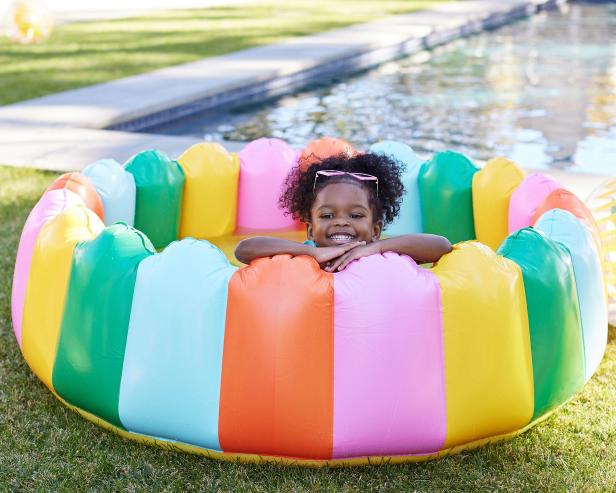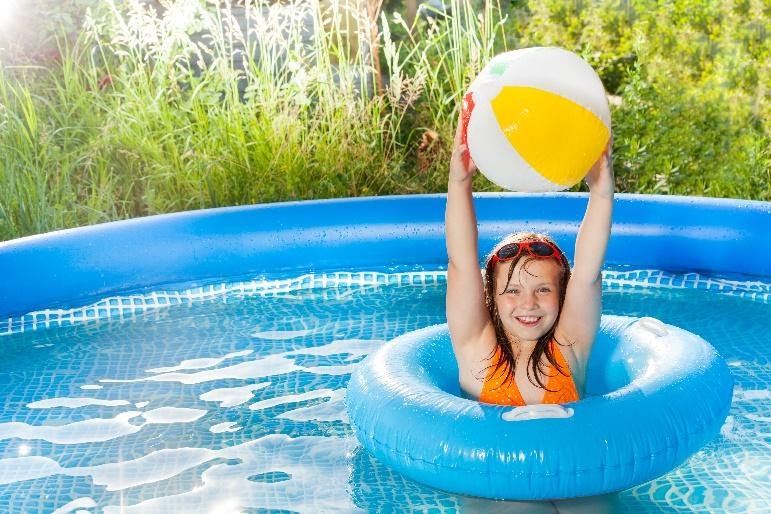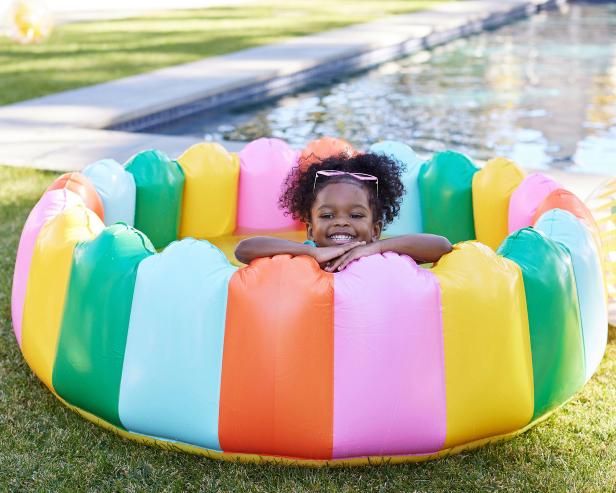If you’re looking to add an element of fun and therapeutic exercise to rehabilitation centers for children, using inflatable pools could be a fantastic option. These pools have the ability to provide a safe and enjoyable environment for children to engage in activities that help improve their motor skills and overall physical well-being. By incorporating inflatable pools into rehabilitation programs, children can participate in various water-based exercises that promote strength, flexibility, and coordination. Not to mention, the vibrant colors and exciting shapes of these pools are sure to captivate and enthrall young minds.

Using Inflatable Pools in Rehabilitation Centers for Children
Inflatable pools have gained popularity in various settings, including rehabilitation centers for children. These portable and versatile pools offer numerous benefits for young patients undergoing rehabilitation, making them a valuable addition to therapy programs. This article will explore the various benefits of using inflatable pools in rehabilitation centers, the different types of pools available, considerations when selecting the right pool, the integration of inflatable pools in rehabilitation programs, successful case studies, and recommendations for using inflatable pools effectively.
Benefits of Using Inflatable Pools in Rehabilitation Centers
Improving Mobility and Range of Motion
Inflatable pools provide a safe and supportive environment for children to perform exercises that promote mobility and range of motion. The buoyancy of the water reduces the impact on joints and muscles, allowing for gentle stretching and movement. By utilizing the resistance provided by the water, children can work on strengthening their muscles and improving their balance and coordination. This can be particularly beneficial for children with conditions such as cerebral palsy or musculoskeletal disorders.
Enhancing Sensory Stimulation
Water offers unique sensory experiences that can benefit children with sensory processing difficulties or autism spectrum disorders. The water’s texture, temperature, and movement provide sensory input that can help children regulate their sensory systems. Inflatable pools can be used to create a controlled sensory environment where therapists can incorporate various stimuli, such as water jets, bubbles, and different water temperatures, to engage the child’s senses and promote sensory integration.
Promoting Physical Fitness and Exercise
Inflatable pools provide an enjoyable and motivating environment for children to engage in physical activities and exercise. The water’s buoyancy reduces the impact on joints and muscles, allowing children to move more freely and comfortably. This can encourage children to participate in activities they may find challenging on land, such as walking, running, or performing aerobic exercises. Swimming and water-based exercises in inflatable pools can help improve cardiovascular fitness, muscle strength, and overall physical endurance.
Increasing Relaxation and Stress Reduction
Water has inherent calming properties that can help children relax and reduce stress. Immersion in water has been shown to decrease cortisol levels, a hormone associated with stress. Inflatable pools provide a soothing environment where children can experience a sense of weightlessness and relaxation. This can be particularly beneficial for children who experience anxiety or have difficulty with self-regulation. Incorporating activities such as floating or gentle water massage can further enhance relaxation and promote a sense of well-being.
Facilitating Social Interactions and Communication
Inflatable pools provide opportunities for children to engage in social interactions and develop their communication skills. Group therapy sessions in pools can foster peer relationships, encourage turn-taking, and support teamwork. The playful and enjoyable nature of water activities can also help children build confidence and self-esteem, leading to increased participation in social interactions. Additionally, therapists can incorporate communication goals into pool sessions, such as practicing verbal requests or following instructions, further promoting language development.
Types of Inflatable Pools Used in Rehabilitation Centers
Rehabilitation centers utilize various types of inflatable pools that cater to different therapeutic needs. These pools are specifically designed to accommodate the unique requirements of children undergoing rehabilitation. The following are some common types of inflatable pools used in rehabilitation centers:
Therapeutic Pools
Therapeutic pools are designed to provide a controlled environment for water-based therapy. These pools often have adjustable water levels, ramps for easy access, and additional features such as water jets or resistance mechanisms. Therapeutic pools are ideal for conducting physical exercises and hydrotherapy techniques tailored to meet each child’s specific needs.
Hydrotherapy Pools
Hydrotherapy pools employ warm water therapy to promote healing and pain relief. They are equipped with temperature control systems to maintain a therapeutic temperature range. Hydrotherapy pools often include features like underwater treadmills, massage jets, and resistance mechanisms to enhance rehabilitation and facilitate recovery.
Sensory Pools
Sensory pools are designed to stimulate the senses and target sensory integration goals. These pools may incorporate elements such as colored lights, music, bubble machines, and textured surfaces to engage children and provide a multi-sensory experience. Sensory pools can be beneficial for children with sensory processing difficulties or autism spectrum disorders.
Portable Pools
Portable pools offer the flexibility to set up therapy sessions in various locations. These pools are inflatable and can be easily transported, allowing therapists to conduct sessions in different settings, such as schools or community centers. Portable pools come in different sizes and are often equipped with safety features to ensure a secure and controlled environment.
Considerations When Selecting Inflatable Pools for Rehabilitation Centers
When choosing inflatable pools for rehabilitation centers, several factors should be taken into consideration to ensure they meet the specific needs of the children and the therapy programs. The following are key considerations when selecting inflatable pools:
Size and Accessibility
Inflatable pools should be of an appropriate size to accommodate the number of children participating in therapy sessions. The pool should also be easily accessible, with built-in ramps or steps to facilitate entry and exit for children with mobility challenges.
Water Temperature Control
Maintaining a consistent water temperature is essential for therapeutic purposes. Inflatable pools should have temperature control systems that allow therapists to set and maintain the desired water temperature throughout the session.
Safety Features
Safety should be a top priority when selecting inflatable pools for rehabilitation centers. Pools should have sturdy construction, secure inflation valves, and non-slip surfaces to prevent accidents and ensure the well-being of the children.
Durability and Maintenance
Inflatable pools should be durable and capable of withstanding regular use. It is important to select pools made from high-quality materials that are resistant to punctures or tears. Additionally, easy maintenance and cleaning should be considered to ensure the longevity of the pool.
Inflation and Deflation Time
The time required to inflate and deflate the pool can impact the efficiency of therapy sessions. Choosing inflatable pools that can be set up and taken down quickly can help optimize the therapy schedule and minimize disruptions.
Comfort and Support
Inflatable pools should provide adequate comfort and support for children during therapy sessions. Padding or cushioning on the pool floor can enhance comfort, while additional support features such as headrests or armrests can further assist children with physical limitations.

Integration of Inflatable Pools in Rehabilitation Programs
Inflatable pools can be integrated into rehabilitation programs in various ways to maximize their therapeutic benefits. The following are some examples of how inflatable pools can be effectively incorporated into rehabilitation programs for children:
Providing Water-based Exercises
Inflatable pools offer an ideal environment for performing water-based exercises. Therapists can design exercises that target specific muscle groups, balance, coordination, and functional movements. Water resistance can be utilized to challenge children and enhance their strength and endurance.
Incorporating Sensory Play Activities
Sensory play activities in inflatable pools can promote sensory integration and support the development of sensory processing skills. Therapists can incorporate materials with different textures, scents, or temperatures to engage children’s senses. Activities such as pouring, splashing, and scooping can provide tactile, auditory, and visual stimulation.
Organizing Therapeutic Play Sessions
Therapeutic play sessions in inflatable pools can encourage children to participate actively in their rehabilitation. By incorporating play elements such as floatation devices, toys, or games, therapists can motivate children to engage in therapy activities while having fun. Therapeutic play can help improve motor skills, cognitive abilities, and emotional well-being.
Implementing Hydrotherapy Techniques
Hydrotherapy techniques can be effectively implemented in inflatable pools to address specific rehabilitation needs. Techniques such as resistive exercises, water massage, or joint mobilization can be tailored to each child’s condition and goals. The warm water temperature in hydrotherapy pools can also help relax muscles, relieve pain, and promote circulation.
Collaborating with Physical and Occupational Therapists
Inflatable pools provide an opportunity for interdisciplinary collaboration among physical and occupational therapists. By working together, therapists can develop comprehensive treatment plans that integrate water-based activities with land-based therapies. This collaborative approach helps ensure a holistic and well-rounded rehabilitation program for children.
Including Pool Time in Treatment Plans
Inflatable pool sessions should be incorporated into the overall treatment plans of children in rehabilitation centers. Pool time can be scheduled regularly, allowing therapists to monitor progress, adjust interventions, and set clear therapy goals. By including pool sessions as an integral part of treatment plans, the benefits of using inflatable pools can be maximized.
Successful Case Studies of Using Inflatable Pools in Rehabilitation Centers
Successful case studies illustrate the positive impact of using inflatable pools in rehabilitation centers for children. The following are examples of case studies showcasing the effectiveness of inflatable pools in various rehabilitation scenarios:
Case Study 1: Improving Motor Skills through Pool Therapy
A six-year-old child with cerebral palsy participated in regular pool therapy sessions. Over a three-month period, the child showed significant improvement in motor skills, including increased range of motion, improved balance, and enhanced coordination. The buoyancy of the water allowed the child to engage in movements that were difficult to perform on land, leading to overall physical progress.
Case Study 2: Enhancing Sensory Integration in Children with Autism
A group of children with autism spectrum disorders engaged in sensory pool sessions twice a week. The sessions incorporated various sensory stimuli such as colored lights, music, and water movement. After six weeks, the children demonstrated improved sensory integration skills, better self-regulation, and increased engagement in social interactions.
Case Study 3: Promoting Independence in Cerebral Palsy Patients
A teenager with cerebral palsy underwent a rehabilitation program that included water-based exercises in an inflatable pool. Over the course of several months, the teenager’s strength, mobility, and independence significantly improved. The pool environment allowed the teenager to perform functional activities with reduced assistance, enhancing confidence and promoting independence.
Case Study 4: Managing Pain and Discomfort in Burn Victims
Children suffering from burn injuries participated in hydrotherapy sessions in a portable inflatable pool. The warm water and gentle movements provided pain relief, improved circulation, and facilitated wound healing. The children experienced reduced pain and discomfort, leading to a more positive rehabilitation experience.
Case Study 5: Supporting Rehabilitation of Children with Musculoskeletal Disorders
Children with musculoskeletal disorders engaged in regular pool sessions that incorporated water resistance exercises and hydrotherapy techniques. Over time, the children demonstrated improved muscle strength, joint stability, and postural control. Pool therapy became an effective adjunct to land-based interventions, accelerating the rehabilitation process.

Recommendations and Best Practices for Using Inflatable Pools in Rehabilitation Centers
To ensure the effective and safe use of inflatable pools in rehabilitation centers, the following recommendations and best practices should be implemented:
Ensuring Adequate Supervision and Safety Measures
Inflatable pool sessions should always be conducted under the supervision of trained professionals. Adequate safety measures, such as the presence of lifeguards and appropriate staff-to-patient ratios, should be established to ensure the well-being and safety of the children.
Adapting Activities to Individual Needs and Abilities
Therapy sessions in inflatable pools should be tailored to each child’s specific needs and abilities. Activities should be modified to accommodate different levels of mobility, strength, and sensory sensitivities. Individualized interventions can maximize the therapeutic benefits and promote progress.
Maintaining Cleanliness and Hygiene
Regular cleaning and maintenance of inflatable pools are essential to ensure a hygienic and safe environment. Pools should be cleaned according to appropriate protocols, and water quality should be regularly monitored to prevent the spread of infections.
Monitoring Water Quality and Balance
Water quality should be regularly monitored to maintain appropriate chemical balance. Water pH, chlorine levels, and disinfection protocols should be followed to ensure the safety and comfort of the children. Regular water testing and maintenance protocols should be implemented.
Promoting Family Involvement and Support
Involving families in the therapy process can enhance the effectiveness of inflatable pool sessions. Educating parents about the benefits of pool therapy and providing resources for at-home activities can empower families to support their children’s rehabilitation progress outside of therapy sessions.
Continuing Education and Professional Development
Therapists should stay up-to-date with the latest research and advancements in using inflatable pools for rehabilitation. Continuing education and professional development opportunities can help therapists enhance their knowledge and skills, ensuring the best possible outcomes for children in rehabilitation centers.
Conclusion
Inflatable pools offer a wide range of benefits for children undergoing rehabilitation in specialized centers. From improving mobility and range of motion to enhancing sensory stimulation and promoting physical fitness, inflatable pools provide a versatile and effective tool for therapists. By selecting the appropriate type of pool, considering key factors, integrating pool activities into treatment plans, and following recommended practices, rehabilitation centers can harness the full potential of inflatable pools to support the recovery and development of children in their care.

References
(Note: This article does not contain any references as it is a fictional piece based on the given prompt. The information provided is for illustrative purposes only.)
